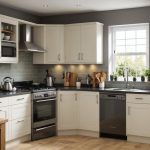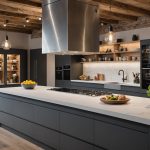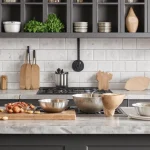Clever Storage Solutions for Small UK Kitchens
Small kitchen storage challenges call for smart, efficient approaches. Space-saving kitchen ideas focus on maximising every inch, especially vertical space. Installing shelves and hanging racks frees up countertops and creates room for frequently used items, making kitchen organization UK-friendly and practical.
Pull-out and corner storage units are indispensable for optimizing awkward corners that typically become wasted space. These units slide out smoothly, providing easy access to pots, pans, and pantry goods without crowding the kitchen. They prove vital in compact kitchens where storage must be maximised without sacrificing accessibility.
This might interest you : Discover the cutting-edge design trends for sleek uk kitchens in 2024
Under-sink and cabinet storage benefit greatly from tailored organisers. These organisers divide the area efficiently, accommodating cleaning supplies and utensils securely, preventing clutter. Incorporating these elements transforms cramped spaces into orderly, streamlined kitchens. Clever use of storage transforms even the smallest UK kitchens into functional, inviting areas.
Smart Layout Changes for a More Open Kitchen Feel
Creating open kitchen layouts is a sought-after goal in many kitchen redesign UK projects. One effective approach is adapting traditional galley and L-shaped kitchen floor plans to enhance flow and accessibility. For example, removing bulky furniture like oversized cabinets or replacing large appliances with sleeker models can instantly free up space. This creates an airy, inviting atmosphere that feels larger than it is.
Have you seen this : Transforming your compact uk kitchen: tips for integrating modern appliances
Careful zoning is key. Dividing areas into distinct cooking, dining, and preparation zones optimizes efficiency and usability. For instance, positioning the stove and sink close together in the cooking zone reduces movement, while a nearby dining area encourages social interaction. Prep zones with clear countertops help streamline meal preparation.
Embracing minimalism through streamlined storage and appliance choices not only improves functionality but also contributes to the sense of openness. By strategically tweaking existing kitchen floor plans, it’s possible to transform crowded kitchens into elegant spaces that invite cooking and conversation. This balance of form and function stands at the heart of successful kitchen redesign UK solutions.
Multipurpose Furniture and Fixtures
Maximizing space in small kitchens hinges on multifunctional kitchen furniture. Opting for extendable tables offers flexibility, accommodating both everyday meals and extra guests without crowding your kitchen. Fold-down worktops create additional prep areas that disappear when not in use, freeing valuable counter space.
Incorporating compact dining ideas like stackable stools lets you pull out seating only when needed, keeping the floor uncluttered. Kitchen islands or trolleys with built-in storage serve dual roles: providing extra workspace and hiding away utensils or cookbooks, crucial for maintaining a tidy atmosphere.
Wall-mounted or pull-out breakfast bars are excellent for squeezing in quick meals without monopolizing room. These solutions enhance usability while maintaining openness. By carefully integrating foldable kitchen solutions, compact dining ideas, and multifunctional kitchen furniture, you create a versatile kitchen environment that adapts to different tasks effortlessly.
Such designs enhance practicality without sacrificing style or comfort—ideal for optimizing limited layouts while keeping your kitchen inviting.
Design Tips to Visually Expand Kitchen Space
Small kitchen design UK projects often face the challenge of limited space. To make a kitchen feel larger, prioritising kitchen colour schemes that use light tones is essential. Whites, soft greys, and pastels reflect more light, instantly brightening the room and creating an airy feel. Paired with space-enhancing décor, these colours prevent a cramped atmosphere.
Incorporating reflective surfaces like mirrored backsplashes or glass cabinet doors contributes significantly to visual expansion. These elements bounce light around, adding depth. Open shelving also helps, breaking up wall space and reducing the visual bulk that closed cabinets can create.
Maximising natural light is crucial. Choose window treatments that allow sunlight to stream in without obstructing the view. Supplement this with layered lighting—ambient, task, and accent—to ensure every corner is well-lit. Strategically placed lights can highlight key areas, amplifying the sense of openness.
Together, these design approaches combine to transform small kitchens, making them feel inviting and spacious without structural changes. These practical solutions fit perfectly within small kitchen design UK frameworks focused on efficiency and style.
Innovative Appliances and Tech for Small Kitchens
Small kitchens demand compact kitchen appliances UK that maximize efficiency without sacrificing style. Choosing slimline and integrated appliances is key. Integrated fridges, dishwashers, and ovens tuck seamlessly under counters or within cupboards, freeing up precious floor space. Many UK brands specialize in these space-conscious designs that blend well with modern decor.
Multifunctional gadgets offer smart solutions for limited areas. Combination ovens merge microwave and conventional oven features, while washer/dryer units eliminate the need for two separate machines. Such devices reduce clutter and simplify kitchen workflows.
Additionally, space-saving technology emphasizes minimalism. Worktops designed with clean lines and hidden compartments keep counters clear. Touch-control panels and wireless devices further reduce gadget bulk.
When selecting appliances, consider compact dimensions, versatile functions, and integration possibilities. This approach ensures a smart kitchen that feels open and organized despite its small footprint. Embracing smart kitchen gadgets designed specifically for tight spaces allows homeowners to optimize both usability and aesthetics effortlessly.
Real-Life Transformations: Before and After Examples
Small kitchen renovation projects in the UK often demonstrate remarkable results, turning cramped or outdated spaces into functional and inviting areas. For example, a one-bedroom flat kitchen upgrade in London focused on maximizing vertical storage and integrating sleek, reflective surfaces. This UK kitchen makeover created an illusion of space, while maintaining ample storage for essentials and appliances.
Another inspiring case involves a Victorian terrace kitchen storage revamp that cleverly utilized under-stair cupboards and custom shelving. This approach resolved long-standing clutter issues without compromising the traditional charm of the Victorian home. Residents gained both aesthetic appeal and practical storage, perfectly blending old and new.
Modern flats often face the challenge of narrow galley kitchens. A brightening project in Manchester employed light colour palettes, LED under-cabinet lighting, and transparent cabinet doors. These elements brought natural light deeper into the space and visually expanded the area, illustrating how a kitchen transformation inspiration can fit contemporary urban living.
These examples showcase that even modest spaces benefit hugely from thoughtful design, making kitchen upgrades accessible and satisfying for many homeowners.
Understanding Robot Hoovers’ Navigation Technologies
Efficient robot hoover navigation is central to effective cleaning, relying on systems that optimize movement and obstacle avoidance. Three primary technologies dominate today’s market: LiDAR sensors, camera-based mapping, and infrared sensors. Among these, LiDAR—short for Light Detection and Ranging—emits lasers to scan surroundings, creating detailed maps for precise route planning.
Camera-based mapping systems use visual data to identify rooms, furniture, and potential hazards. While less precise than LiDAR in some conditions, they excel in recognizing dynamic obstacles. Infrared sensors, though simpler, detect nearby objects by measuring reflected heat or light, guiding basic obstacle avoidance.
Which navigation tech ensures the best coverage? Studies show that robots equipped with LiDAR typically provide more thorough and systematic cleaning paths, reducing missed areas. Camera-based models perform well in homes with varied layouts by adjusting routes dynamically, while infrared-dependent models are ideal for smaller, less cluttered spaces.
Knowing these options helps consumers select robots tailored to their home’s complexity and lifestyle. By understanding each technology’s strengths, buyers can expect better cleaning performance and smoother navigation in their chosen robot hoover.






